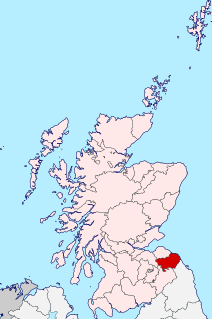Lauder in Berwickshire was a royal burgh that returned one commissioner to the Parliament of Scotland and to the Convention of Estates.

The former Royal Burgh of Lauder is a town in the Scottish Borders in the historic county of Berwickshire. On the Southern Upland Way, the burgh lies 27 miles (43 km) southeast of Edinburgh, on the western edge of the Lammermuir Hills.

Berwickshire is a historic county, registration county and lieutenancy area in the Scottish Borders. It takes its name from Berwick-upon-Tweed, which was part of Scotland at the time of the county's formation, but became part of England in 1482 after several centuries of being fought over and swapping back and forth between the two kingdoms.

A royal burgh was a type of Scottish burgh which had been founded by, or subsequently granted, a royal charter. Although abolished in law in 1975, the term is still used by many former royal burghs.
Contents
After the Acts of Union 1707, Lauder, North Berwick, Dunbar, Haddington and Jedburgh formed the Haddington district of burghs, returning one member between them to the House of Commons of Great Britain.

The Acts of Union were two Acts of Parliament: the Union with Scotland Act 1706 passed by the Parliament of England, and the Union with England Act passed in 1707 by the Parliament of Scotland. They put into effect the terms of the Treaty of Union that had been agreed on 22 July 1706, following negotiation between commissioners representing the parliaments of the two countries. By the two Acts, the Kingdom of England and the Kingdom of Scotland—which at the time were separate states with separate legislatures, but with the same monarch—were, in the words of the Treaty, "United into One Kingdom by the Name of Great Britain".
North Berwick in Haddingtonshire was a royal burgh that returned one commissioner to the Parliament of Scotland and to the Convention of Estates.
Dunbar in Haddingtonshire was a royal burgh that returned one commissioner to the Parliament of Scotland and to the Convention of Estates.